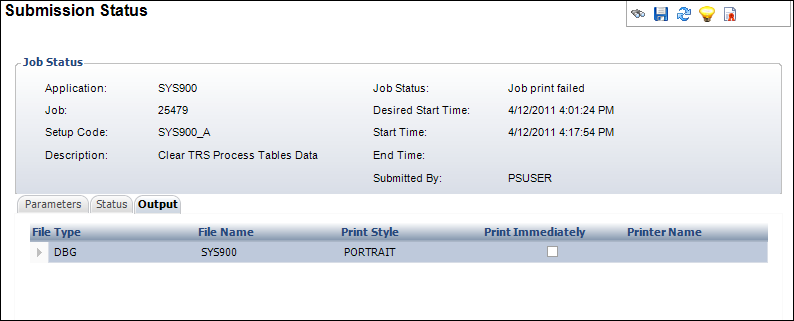The Submission Status screen displays, as shown below.

The Job Status screen enables you to check the status of a submitted report. Several of the status values include:
· Job Completed
· Job Ended
· Failed
· Job in Process
· Job Print Failed
· Job Stop Complete
· Job Stop Failed
From this screen, you can copy the final output report to another location on the network or to your computer. In addition, you can view reports online or print them on a local or network printer.
The Submission Status screen includes three tabs. Those tabs include:
· Parameters Tab – lists the parameters for the report/process selected. This read-only table specifies the name of the parameter and the corresponding value given to it. The name of the job parameters used in the submission of the process. Each report uses different parameters.
· Status Tab – lists the statuses of a job submission, the date and time of the submission, and any messages associated with the status code. The tab consists of the following:
o Status Code: A code representing the condition of the submitted job. For example, “NEW,” “STARTED,” “RUNNING,” or “COMPLETED”.
o Status Description: A description of the condition of the submitted job as it pertains to the code entered.
o Status Date: The date and time of the assessed condition of the submitted job. A job with a status code of “RUNNING” would be somewhere in the middle of the job.
o Log Message: This provides an explanation about the status and pertains only to statuses that warrant an explanation.
· Output Tab – lists the file types used to process the end product. A job can produce a number of output files that you can view. For example, a Summary report, a Detail report, or a Skipped report. You can print the files in portrait or landscape style. This tab usually contains a DBG file. Before you submit a job, the DBG file records all the processes that are running on the server and displays how much memory the processes take. The tab consists of the following:
o File Type: The type of output file, such as a report.
o File Name: The name of the file consisting of the abbreviation for the subsystem and a code number. The output files include a summary report, a detail report, or a skipped report.
o Print Style: The printed format of the output. For example, portrait or landscape.
o Print Immediately: This allows you to print the output right away, if desired.
o Printer name: The name of the printer.
To view the job submission status:
1. From the toolbar, select Reporting > Job and Report Status.
2. Search
for and select the appropriate job.
The Submission Status screen displays, as shown below.

 All
records in red have not been completed and are failed reports. All records
in black have been completed successfully.
All
records in red have not been completed and are failed reports. All records
in black have been completed successfully.
3. Review the information on the Parameters, Status, and Output tabs.
4. Select the appropriate option from the Standard Tasks task category:
· Place on Hold – As of the 7.2.3 release, you can place a job with a status of “New” on hold. You cannot place a job on hold once it has started, so this functionality is only available when you stop the TRS service before submitting or with scheduled jobs, as these jobs will have a status of “New.” Please note that if you have linked jobs, you must manually place them all on hold using this screen.
5. Click Save.